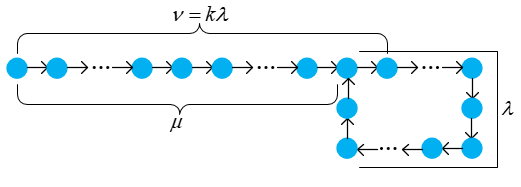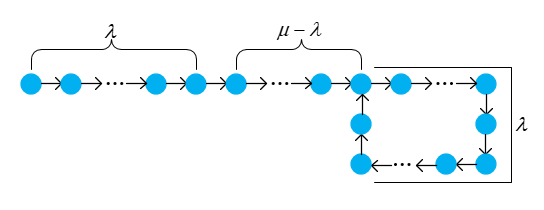Leetcode Summary 01 — Cycle Detection
前言
前段时间忙于找工作,因而有正大光明的托词和导师说,11月之后再去做课题相关的事情,也就有了一段较为自由的时间。
其中诸多准备,免不了在Leetcode上刷题,虽然对于最终的结果来说没有帮助,但刷题过程中遇到了一些解决思路相似的问题,就依次将这些共性问题阐述一遍罢了。
本系列的第一篇介绍的是环检测问题,对应的维基百科页面有Cycle detection。这类问题最常见的求解算法是Floyd Cycle Algorithm/Floyd’s Tortoise and Hare,中文名通常为Floyd判圈算法/龟兔赛跑算法。
1. 问题描述
在计算机科学中,有一类问题称之为环检测问题,即对于一个由迭代函数(iterated function)值组成的序列,判断该序列是否有环及环出现的位置。
关于什么是迭代函数(iterated function),严格定义可以查看这里,简单来说就是一个函数\(f\),其定义域和值域都是集合\(X\),那么对于某个自变量/输入\(a\),其因变量/输出\(b\)也可以作为函数\(f\)的自变量/输入,如此给定一个初始值\(x\),将\(f\)的每一次输出作为下一次的输入,如此重复\(n\)次,就称作函数\(f\)的第\(n\)次迭代。
对于上述函数\(f\),如果其集合\(X\)是有限的,那么对于序列:
$$
S = \{x_0, x_1 = f(x_0), x_2 = f(x_1), \cdots, x_i = f(x_{i-1}), \cdots\}
$$
那么必然会有两个位置\(i\)和\(j\),且\(i < j\),其\(x_i = x_j\),一旦出现这种状况,显然在\(j\)位置之后,会重复从\(x_i\)到\(x_{j-1}\)的序列。所谓环检测问题,就是给定\(f\)和\(x_0\),要求找到\(i\)和\(j\)。
当然对于无限集合\(X\),是有可能不存在环的,这取决于\(f\)和\(x_0\)的共同作用。例如\(f=x^2\),如果\(X\)的范围是复数域,那么\(x_0=0,1,-1,e^{\frac{2\pi{}mi}{n}}\),则有环,否则没有。这里\(m\)的取值范围是整数,\(n\)的取值范围是\({1,2,3,4,6,7,8,12,14,15,16,24,28,30,31,32,\cdots}\),就不仔细推导了,有兴趣的可以自行推导。
2. 求解算法
对于上述问题,最常见的算法是Floyd’s Tortoise and Hare,其次还有Brent’s algorithm和Gosper’s algorithm等。
最直接的想法是记录每次迭代的值,建立一个hash表,这样可以在重复出现时直接定位,但是这种方法空间复杂度太高,故弃。
2.1 Floyd’s Tortoise and Hare
对于问题描述中迭代函数组成的序列,如果存在环,那么对于\(i\ge{}\mu\),则\(x_i = x_{i+k\lambda}\),其中\(\lambda\)是环的长度,\(\mu\)是环的第一个元素出现的位置。
基于此,可以推出,\(\exists{}i = k\lambda\ge\mu\Longrightarrow{}x_i = x_{2i}\)
因此,只要设定两个指针\(P1\)和\(P2\),其中\(P2\)的步长是2,\(P1\)的步长是1,那么就可以找到两个指针指向值相等的位置,反过来说,即只要存在相等值,就存在环,此时可以得出\(\nu = P2 - P1 = P1 = k\lambda\).
显然\(x_{\mu{}+\nu} = x_{\mu}\),即\(x_{\nu{}+\mu} = x_{\mu}\),故找到上述位置之后,\(P1\)仍保持原来位置,而\(P2\)放回序列最初位置,此时两个指针的推进步长都设置为1,两指针指向的值再次相等时,就是环开始的位置。找到环开始的位置后,向后迭代找到下一次重复位置,就可以得到环的长度\(\lambda\)了。
2.2 Brent’s algorithm
Floyd’s Tortoise and Hare算法很精巧,但是判断环存在、找到环开始位置和确定环长度需要分为三步,Brent’s algorithm效率更高,且只需要两步。
Brent’s algorithm也是利用了快慢两个指针的想法,但是它的想法是动态增加步长,加快搜索速度。
其基本意图是设立两个指针,尽快让第一个指针到达环内,然后第二个指针以步长1前进,再次相等时走过的步数正好是环的长度\(\lambda\),具体做法如下。
首先,设定两个指针\(P1\)和\(P2\),\(P2\)第一次先前进\(2^0=1\)步,在前进的过程中若始终\(x_{P2}\ne{}x_{P1}\),则令\(P1 = P2\),然后\(P2\)再前进\(2^1=2\),在前进的过程中若始终\(x_{P2}\ne{}x_{P1}\),则令\(P1 = P2\),然后\(P2\)再前进\(2^2=4\)……
如此,直到出现相等的位置,在出现相等位置之前,最后一次\(P2\)前进的步数就是环的长度\(\lambda\)。
此时,将\(P1\)放于序列开始位置0,\(P2\)放于\(\lambda\)位置,由于\(x_{\mu} = x_{\lambda{}+\mu}\),故只要让\(P1\)和\(P2\)依次向前前进,等到两者指向值相同时,\(P1\)的位置正好就是环的开始位置。
Brent’s algorithm的效率比Floyd’s Tortoise and Hare要高,最差情况是Floyd’s Tortoise and Hare算法。其主要原因是,步长动态增加,速度提高,以及首次找到相同值时,记录了环的长度,而Floyd’s Tortoise and Hare算法首次找到相同值时,并不知道环的长度,只能知道环长度的整数倍。
2.3 Gosper’s algorithm
Gosper算法可以参考此处,Kino还没有细看,就不细说了。
3. 相关练习
Leetcode上有以下数题与此相关。
3.1 Leetcode 141. Linked List Cycle
Description: Given a linked list, determine if it has a cycle in it.
Floyd’s Tortoise and Hare
class Solution {
public:
bool hasCycle(ListNode *head) {
if(!head || !(head->next)) {
return false;
}
ListNode* tortoise = head->next;
ListNode* hare = head->next->next;
while(hare && hare->next) {
if(tortoise == hare) {
return true;
}
tortoise = tortoise->next;
hare = hare->next->next;
}
return false;
}
};Brent’s algorithm
class Solution {
public:
bool hasCycle(ListNode *head) {
if(!head || !(head->next)) {
return false;
}
int current_step = 1;
int limited_step = 1;
ListNode* tortoise = head->next;
ListNode* hare = head->next->next;
while(hare && hare->next) {
if(tortoise == hare) {
return true;
}
if(current_step == limited_step) {
current_step = 0;
limited_step *= 2;
tortoise = hare;
}
hare = hare->next;
current_step++;
}
return false;
}
};3.2 Leetcode 142. Linked List Cycle II
Description: Given a linked list, return the node where the cycle begins. If there is no cycle, return null.
Floyd’s Tortoise and Hare
class Solution {
public:
ListNode *detectCycle(ListNode *head) {
if(!head || !(head->next)) {
return NULL;
}
ListNode* tortoise = head->next;
ListNode* hare = head->next->next;
while(tortoise != hare) {
if(!hare || !(hare->next)) {
return NULL;
}
tortoise = tortoise->next;
hare = hare->next->next;
}
tortoise = head;
while(tortoise != hare) {
tortoise = tortoise->next;
hare = hare->next;
}
return tortoise;
}
};Brent’s algorithm
class Solution {
public:
ListNode *detectCycle(ListNode *head) {
if(!head || !(head->next)) {
return NULL;
}
int current_step = 1;
int limited_step = 1;
ListNode* tortoise = head->next;
ListNode* hare = head->next->next;
while(tortoise != hare) {
if(!hare || !(hare->next)) {
return NULL;
}
if(current_step == limited_step) {
current_step = 0;
limited_step *= 2;
tortoise = hare;
}
hare = hare->next;
current_step++;
}
tortoise = head;
hare = head;
while(current_step--) {
tortoise = tortoise->next;
}
while(tortoise != hare) {
tortoise = tortoise->next;
hare = hare->next;
}
return tortoise;
}
};3.3 Leetcode 202. Happy Number
Description: Write an algorithm to determine if a number is “happy”.
A happy number is a number defined by the following process: Starting with any positive integer, replace the number by the sum of the squares of its digits, and repeat the process until the number equals 1 (where it will stay), or it loops endlessly in a cycle which does not include 1. Those numbers for which this process ends in 1 are happy numbers.
Floyd’s Tortoise and Hare
class Solution {
public:
bool isHappy(int n) {
int tortoise = nextNum(n);
int hare = nextNum(nextNum(n));
while(tortoise != hare) {
tortoise = nextNum(tortoise);
hare = nextNum(nextNum(hare));
}
return tortoise == 1;
}
int nextNum(int n) {
int nxt = 0;
while(n) {
int digit = n%10;
nxt += digit*digit;
n /= 10;
}
return nxt;
}
};Brent’s algorithm
class Solution {
public:
bool isHappy(int n) {
int current_step = 1;
int limited_step = 1;
int tortoise = nextNum(n);
int hare = nextNum(nextNum(n));
while(tortoise != hare) {
if(current_step == limited_step) {
current_step = 0;
limited_step *= 2;
tortoise = hare;
}
hare = nextNum(hare);
current_step++;
}
return tortoise == 1;
}
int nextNum(int n) {
int nxt = 0;
while(n) {
int digit = n%10;
nxt += digit*digit;
n /= 10;
}
return nxt;
}
};3.4 Leetcode 287. Find the Duplicate Number
Given an array nums containing n + 1 integers where each integer is between 1 and n (inclusive), prove that at least one duplicate number must exist. Assume that there is only one duplicate number, find the duplicate one.
Floyd’s Tortoise and Hare
class Solution {
private:
vector<int> nums;
public:
int findDuplicate(vector<int>& nums) {
if(nums.empty()) {
return -1;
}
this->nums = nums;
int tortoise = f(nums[0]);
int hare = f(f(nums[0]));
while(tortoise != hare) {
tortoise = f(tortoise);
hare = f(f(hare));
}
tortoise = nums[0];
while(tortoise != hare) {
tortoise = f(tortoise);
hare = f(hare);
}
return tortoise;
}
int f(int n) {
return nums[n];
}
};Brent’s algorithm
class Solution {
private:
vector<int> nums;
public:
int findDuplicate(vector<int>& nums) {
if(nums.empty()) {
return -1;
}
this->nums = nums;
int current_step = 1;
int limited_step = 1;
int tortoise = f(nums[0]);
int hare = f(f(nums[0]));
while(tortoise != hare) {
if(current_step == limited_step) {
current_step = 0;
limited_step *= 2;
tortoise = hare;
}
hare = f(hare);
current_step++;
}
tortoise = nums[0];
hare = nums[0];
while(current_step--) {
tortoise = f(tortoise);
}
while(tortoise != hare) {
tortoise = f(tortoise);
hare = f(hare);
}
return tortoise;
}
int f(int n) {
return nums[n];
}
};4. 实际应用
环检测(cycle detection)问题的实际应用有 伪随机数生成器(pseudorandom number generators)强度的度量,比如 线性同余生成器(linear congruential generator),加密哈希函数的冲突检测,细胞自动机(cellular automaton)的振荡周期配置等

